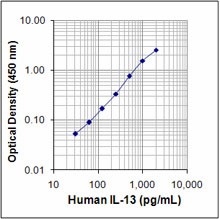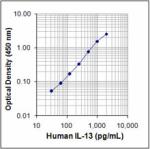- Clone
- Poly5020 (See other available formats)
- Regulatory Status
- RUO
- Other Names
- Interleukin-13, NC30
- Isotype
- Rabbit Polyclonal IgG

| Cat # | Size | Price | Quantity Check Availability | ||
|---|---|---|---|---|---|
| 502001 | 50 µg | $375.00 | |||
IL-13 is an immunoregulatory cytokine produced primarily by activated Th2 lymphocytes. IL-13 shares 30% amino acid sequence homology with IL-4 and demonstrates similar biological activities. The biological activities of IL-13 include: suppression of macrophage cytotoxic activity, upregulation of IL-1RA expression, and suppression of proinflammatory cytokine secretion. The poly5020 polyclonal antibody reacts with human interleukin-13 (IL-13).
Product Details
- Verified Reactivity
- Human
- Antibody Type
- Polyclonal
- Host Species
- Rabbit
- Immunogen
- Recombinant human IL-13
- Formulation
- Phosphate-buffered solution, pH 7.2, containing 0.2% BSA and 0.09% sodium azide.
- Preparation
- The antibody was purified by affinity chromatography, and conjugated with biotin under optimal conditions.
- Concentration
- 0.2 mg/mL
- Storage & Handling
- The antibody solution should be stored undiluted between 2°C and 8°C. Do not freeze.
- Application
-
ELISA Detection, ELISPOT Detection
- Recommended Usage
-
Each lot of this antibody is quality control tested by ELISA assay. As a detection antibody in ELISA assays, dilute 60 µl of this biotinylated antibody into 12 ml of detection buffer for one 96 well microtiter plate assay. To obtain a linear standard curve, serial dilutions of human IL-13 recombinant protein ranging from 2000 to 8 pg/ml are recommended for each ELISA plate. It is recommended that the reagent be titrated for optimal performance for each application.
- Application Notes
-
ELISA Detection or ELISPOT Detection: The biotinylated Poly5020 antibody is useful as a detection antibody for a sandwich ELISA or ELISPOT assay, when used in conjunction with purified JES10-5A2 (Cat. No. 501902/501910) antibody as the capture antibody.
This product may contain other non-IgG subtypes. - Additional Product Notes
-
This antibody can be used for 4 plates.
-
Application References
(PubMed link indicates BioLegend citation) -
- Bailer, R.T., et al.., 1999. J. Immunol.. 162 :7534.
- Arva, E., et al.., 1999. Scand. J. Immunol.. 49:411.
- Product Citations
-
- RRID
-
AB_2124285 (BioLegend Cat. No. 502001)
Antigen Details
- Structure
- Cytokine; 12.5 kD
- Function
- Suppression of macrophage cytotoxic activity; upregulation of IL-1RA expression; suppression of IL-1, IL-6, IL-8, IL-10, IL-12, chemokines MCP, MIP-1; differentiation of B cells, monocytes
- Bioactivity
- Suppression of macrophage cytotoxic activity; upregulation of IL-1RA expression; suppression of IL-1, IL-6, IL-8, IL-10, IL-12, chemokines MCP, MIP-1; differentiation of B cells, monocytes
- Cell Sources
- Activated T helper cells, CD8+ T cells, mast cells, NK cells
- Cell Targets
- B cells, monocytes, macrophages, basophils
- Receptors
- Moderate affinity IL-13Rα1; high affinity heterodimer IL-13Rα1/IL-4Rα also binds IL-4; both receptor complexes have γ-subunit in common with IL-2R, IL-4R, IL-7R, IL-15R ; high affinity IL-13Rα2 incapable of signaling
- Cell Type
- Tregs
- Biology Area
- Cell Biology, Immunology, Neuroinflammation, Neuroscience
- Molecular Family
- Cytokines/Chemokines
- Antigen References
-
1. Fitzgerald, K., et al. Eds. 2001. The Cytokine FactsBook. Academic Press, San Diego.
2. Hilton, D., et al. 1996. P. Natl. Acad. Sci. USA 93:497.
3. Obiri, N., et al. 1995. J. Biol. Chem. 270:8797.
4. Ochensberger, B., et al. 1996. Blood 88:3028. - Regulation
- IL-13Rα2 possible antagonist
- Gene ID
- 3596 View all products for this Gene ID
- UniProt
- View information about IL-13 on UniProt.org
Other Formats
View All IL-13 Reagents Request Custom Conjugation| Description | Clone | Applications |
|---|---|---|
| Biotin anti-human IL-13 | Poly5020 | ELISA Detection,ELISPOT Detection |
Compare Data Across All Formats
This data display is provided for general comparisons between formats.
Your actual data may vary due to variations in samples, target cells, instruments and their settings, staining conditions, and other factors.
If you need assistance with selecting the best format contact our expert technical support team.


